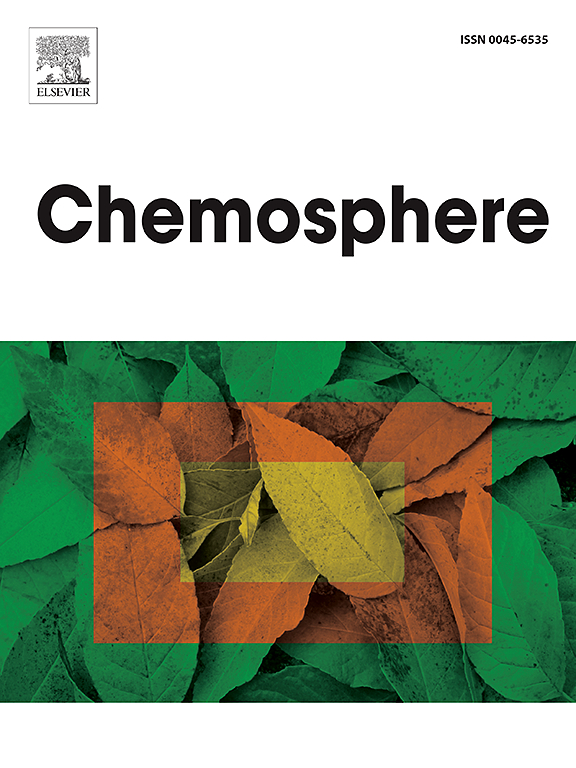生物炭作为一种可持续的吸附剂去除酸性矿山废水中的镧系元素
IF 8.1
2区 环境科学与生态学
Q1 ENVIRONMENTAL SCIENCES
引用次数: 0
摘要
含有镧系元素(Ln)的矿石的提取和加工产生大量的废物,可能导致富镧的渗滤液和酸性矿山排水(AMD)。AMD的特点是酸性pH值和高铁(Fe)浓度。由于这些渗滤液的环境风险,有必要采用有效的补救策略来降低渗滤液影响水域的Ln浓度。在这种情况下,研究人员研究了生物炭作为一种可持续的、具有成本效益的替代方法来处理这些水。本研究探讨了两种生物炭材料(来自松枝(PB)和园林废弃物(GaW))去除污染水体(包括AMD)中Ln (La, Sm和Lu)的可行性。使用连续流吸附技术模拟了使用生物炭屏障进行水过滤的真实场景。最初,测试了两种添加sm的水基质,双去离子水(DD)和河流淡水(FW),结果显示,尽管基质之间的pH值、溶解有机物和水溶性阳离子浓度略有差异,但所获得的生物炭吸附能力没有统计学上的显著差异(DD和FW两种情况下,PB分别为220和216 meq kg - 1, GaW分别为459和392 meq kg - 1)。对于混合Ln污染(La + Sm + Lu), Ln在生物炭吸附位点上分布均匀,而混合Ln污染与仅Sm污染相比,生物炭的总体吸附能力相似。经过初步测试后,在模拟的AMD基质中测试了生物炭材料从AMD中吸收Ln的效率。具有高缓冲能力的生物炭材料,如在这项工作中测试的那些,被认为是处理受镧污染的AMD的合适选择,前提是调整操作时间,使其不超过材料的酸中和能力。本文章由计算机程序翻译,如有差异,请以英文原文为准。

Biochar as a sustainable sorbent for the removal of lanthanides from acid mine drainage
The extraction and processing of ores containing lanthanides (Ln) generate significant amounts of waste that may lead to Ln-rich leachates and acid mine drainage (AMD). AMD is characterised by an acidic pH and high iron (Fe) concentrations. Due to the environmental risk of these leachates, there is a need to apply effective remediation strategies to decrease Ln concentrations in leachate-affected waters. In this scenario, biochar was investigated as a sustainable and cost-effective alternative for the treatment of these waters. This study explored the viability of two biochar materials (derived from pine branches (PB) and garden wastes (GaW)) for the removal of Ln (La, Sm and Lu) from contaminated waters, including AMD. A continuous-flow sorption technique was used to simulate a real scenario of water filtration using a biochar barrier. Initially, two Sm-spiked water matrices, double-deionised water (DD) and river freshwater (FW) were tested, revealing no statistically significant differences in the biochar sorption capacities obtained (220 and 216 meq kg−1 for PB, 459 and 392 meq kg−1 for GaW in DD vs. FW scenarios, respectively), despite the slight differences in pH, dissolved organic matter, and water-soluble cation concentrations between the matrices. For mixed Ln contamination (La + Sm + Lu), Ln appeared to be equally distributed at the biochar sorption sites, whereas the biochar showed a similar overall sorption capacity when comparing mixed Ln contamination to only Sm contamination. After the initial tests, the efficiency of the biochar materials to sorb Ln from AMD was tested in a simulated AMD matrix. Biochar materials with high buffering capacity, such as those tested in this work, were considered a suitable option for the treatment of Ln-contaminated AMD, provided that the operation times are adapted so as not to exceed the acid neutralising capacity of the material.
求助全文
通过发布文献求助,成功后即可免费获取论文全文。
去求助
来源期刊

Chemosphere
环境科学-环境科学
CiteScore
15.80
自引率
8.00%
发文量
4975
审稿时长
3.4 months
期刊介绍:
Chemosphere, being an international multidisciplinary journal, is dedicated to publishing original communications and review articles on chemicals in the environment. The scope covers a wide range of topics, including the identification, quantification, behavior, fate, toxicology, treatment, and remediation of chemicals in the bio-, hydro-, litho-, and atmosphere, ensuring the broad dissemination of research in this field.
 求助内容:
求助内容: 应助结果提醒方式:
应助结果提醒方式:


